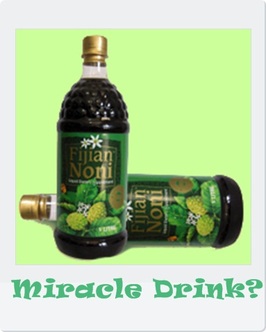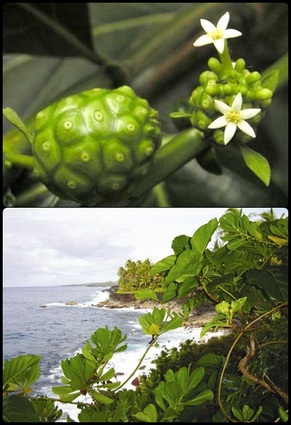Not Your Ordinary Fruit Juice
 This blog is dedicated to all noni juice lovers and believers as well as to those who question this amazing food supplement. Noni juice has been sold and promoted widely nowadays as a miracle drink due to the positive effects it has in the body as reported by noni juice drinkers and producers. Referring it as a “miracle drink” has caused so much controversies. So let’s just leave it as a nutritional supplement that's indeed worth trying.People from many corners in the world may have experience amazing benefits from drinking noni juice, but some of these benefits have not been supported by scientific evidences. The one thing I’m sure about noni juice is it’s not your ordinary fruit juice for it possess something that’s incomparable to other fruit juices. This is the reason why people considerably drink this juice regularly despite its bitter taste. Behind noni juice’s bitter taste lies so many essential compounds and nutrients that health experts have identified. Learn what are these compounds and the common uses of noni juice before and today.
What's in Noni Juice?  Scientifically called Morinda citrifolia, this small evergreen shrub that bears greenish to yellowish ovoid-shaped noni fruits has been one of the most prized plants in the Tropics. Believed to have originated in Polynesia, noni fruit, cheese fruit or Indian mulberry has been used by Polynesians as a cure to several health problems, as an energy and immune system booster for many centuries. Nowadays, people have heard of noni fruit extract or noni juice as a controversial food supplement. Controversies about this drink inevitably arise due to the countless health claims regarded to this fruit juice. Most people though see it as an effective herbal cure to several conditions, from skin rash to chronic inflammatory diseases such as arthritis. Some people also believed that noni extract is a potent nutritional supplement that’s worth trying. Whilst most people view noni positively, few people still have their doubts, questioning its effectiveness. The doubts and questions have prompted medical professionals and researchers to conduct several extensive studies for the search of the ultimate truth regarding noni juice health benefits. Laboratory experiments and researches have led them to find out the real benefits as well as the “overstatements” regarded to noni juice. One of these truths is, there are 150+ antioxidants, nutrients and nutraceutucals identified by experts in noni juice. These compounds are believed to be the key components behind noni’s limitless effects in the body.
 Before learning about the 150+ compounds in noni fruit, get to know how people use this tropical evergreen shrub for several health-promoting and curative purposes. From its roots, flowers to its fruit extract, noni fruit has been used not just by Ancient Polynesians but by a large percentage of health conscious individuals nowadays.
- Noni fruit has been used as a cure to intestinal parasitism
- Noni extract has been used to alleviate signs and symptoms of respiratory ailments such as cough and colds.
- A liquid concoction made from ground noni leaves, roots, fruit and water was used by Polynesians to treat diarrhea while boiled bark decoctions were used for digestive ailments.
- Noni fruit extract has been used to stimulate delayed menstrual cycles.
- Noni leaves and extract have been used to treat inflammations, ring worm and adult gingivitis.
- Noni leaf and fruit extracts have been used to alleviate pain due to arthritis, muscle strains and injuries.
- Noni leaves were used to treat abscesses and boils.
- Noni fruit extract has been used to boost energy and immune system
- Noni leaves were also used to control blood sugar in people with diabetes.
- Noni fruit extract has been used to reduce and normalize cholesterol levels.
Some noni juice’s manufacturers use only fully ripened fruit in the extraction of juice. About 5 lbs. or 2 kg of fresh Noni fruit are extracted to produce 32 oz. (960 ml) of Noni Juice. Generally, the color of Noni juice is golden amber to reddish dark brown, which may vary upon its age. Occasionally, noni juice contains some pulp.
Ripe Noni fruits are harvested and cleansed. They will usually age and ferment for 3-4 weeks, juicing itself. The juice will be collected or extracted, pasteurized and then bottled.
 Here’s the list of Nutraceuticals, Antioxidants and Nutrients Identified in Noni:
Among the following compounds, proxeronine is the most compelling and most studied ingredient of noni juice. Proxeronine is the precursor of xeronine molecules, compounds needed by the body for protein assimilation. By drinking noni juice, we absorb proxeronine, xeronine molecules then are produced, which would bind to specific protein molecules in order to function to the optimum level. Not all proteins need xeronine but most protein molecules are not able to function without xeronine. Protein has several significant roles in the body, ranging from basic functions like tissue repair to complex ones such as hormone production, and nutrient transport inside and outside body cells. Experts believed that proxeronine is the key component behind most of noni juice’s miraculous effects in the body.
Bioflavonoids
Glucopyranose
Arginine
Scopoletin
Morindine
Asperuloside
Leucine
Proxeronine
Morindone
Serotonin
Aspartate
Morindadiol
Terpenes
Precursors
Lysine
Proxeronase
Plant Sterols
Vitamins
Cysteine
Rubiadin
Iron
Trace elements
Phenlyalanine
Serotonin
Sitosterol
Alkaloids
Cystine
| Magnesium
Phosphate
Enzymes
Threonine
Damnacanthal
Glycosides
Serine
Glycine
Carbonate
Carbohydrates
Multi-receptor
Trypophane
Nordamnacanthal
Alizarin
Activators
Glutamate
Protein
Acetin GlucoP
Chlororubin
Valine
| Caproic acid
Alanine
Histadine
Carotenoids
Caprlyic
Isolucine
Proline
Bioflavinoids
Glucopyranose
Arginine
Scopoletin
Morindine
Asperuloside
Leucine
Iron
Trace elements
Phenlyalanine
Serotonin
Sitosterol
Alkaloids
| Damnacanthal
Glycosides
Serine
Glycine
Carbonate
Carbohydrates
Multi-receptor
Trypophane
Nordamnacanthal
Alizarin
Activators
Glutamate
Protein
Acetin GlucoP
Chlororubin
Valine
Anthraquinones
Ursolic acid
Methionine
| Tyrosine
Sodium
Anthraquinones
Ursolic acid
Methionine
Tyrosine
Sodium
Cystine
Magnesium
Phosphate
Enzymes
Threonine
Caproic acid
Alanine
Histadine
Carotenoids
Caprlyic
Isolucine
Proline |
|




 RSS Feed
RSS Feed